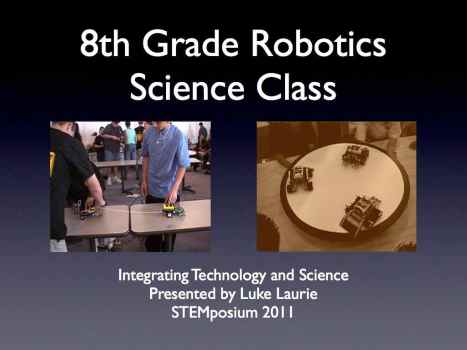Blog Post from Luke Laurie’s Teacher Blog: https://lukelaurie.wordpress.com/
My Robotics science class was the focus of a five minute presentation I recently did at Microsoft’s Mountain View facility, as a Semifinalist for the STEMposium competition, on March 12, 2011. Below are the slides from the presentation, and the script of my remarks.
My name is Luke Laurie. Today I’m going to tell you about the Robotics Science Class that I’ve been teaching for seven years.
Let me tell you a few things about myself.
Science Teacher 13 years -El Camino Junior High in Santa Maria, CA I teach a student population who are mostly English Language Learners, and almost all live in poverty. My school is not unlike many schools in California.
MESA Advisor 13 years -MESA is a statewide program focused on hands-on activities and college attainment in Mathematics, Engineering, and Science
RoboChallenge Director 10 years -A collaborative regional program funded in part by grants from UCSB, providing robotics materials, competition rules, audio-visual and web-based resources, and teacher support to several schools.
Albert Einstein Distinguished Educator Fellow- in the U.S. House of Representatives with Congressman Mike Honda, where I worked for a year on Education and Science Policy
and… I Still play LEGOs
From all of my experience in various STEM programs and STEM education policy, it is clear to me that
STEM must be a part of the core curriculum.
In our schools:
We teach science
And we teach Math
but our students need to know more. We need to ensure that they all have opportunities to explore the concepts of technology and engineering too.
To me, it’s artificial to teach Science without integrating technology, engineering, and mathematics. That’s why I created the Robotics Science Class.
Kids need more STEM experiences and they need to begin them at a young age to have meaningful impact on their lives.
To change the face of STEM, we need to remove the barriers that keep STEM out of reach for most of our students.
The best STEM education programs don’t require high costs or major sacrifices, nor steep qualifications to participate. Good STEM education needs to be easy to access.
Unfortunately, too often, STEM programs don’t reach the student populations that need them the most, and target their efforts only at small teams in after school settings, or to select students during summer programs.

We do have a way to reach all students with high quality STEM education. We have our public schools. And in our schools we need to look at what we’re doing, and make STEM an integral part of our curriculum, and we must implement policies to provide schools with the technical resources, and training they need.
By making my class open to all students, during the school day, and part of the core curriculum, I have enabled hundreds of kids from disadvantaged backgrounds to gain STEM skills and experience they might not otherwise have had.
My students learn that there are tremendous career opportunities for people with STEM skills, and STEM skills are becoming increasingly important to all careers.
The Robotics Science Class integrates California 8th grade physical science standards with the design, construction, and programming of autonomous robots for a variety of fun and interesting challenges.
Students are learning all the California State Standards for Science, including conceptual physics, chemistry, and astronomy, while also learning to use computers and robotics materials as creative tools to solve complex problems.
The Robotics Science Class adds technology and engineering to the science curriculum in a manner that is effective and efficient.
The class primarily uses low cost, durable, flexible, and easy to use LEGO Mindstorms robotics materials, but we’ve used other materials too.
Some of our challenges have included Tug O’War, Sumo, Linefollowing, Robotic Soccer, and Robotic Exploration.
Students learn computer programming concepts using an object-based programming environment where they aren’t stuck dealing with syntax errors and arcane symbols, and instead can focus on the logic of their programs and how to use the sensors and motors to control their robots.
Robotics is a great way to bring all of the aspects of STEM together. Kids love robots, and the idea of working on them is highly motivating. I believe that with more classes like my Robotics Science Class, we will vastly improve STEM education in California.
Thank you for giving me the opportunity to speak to you today.
If you wish more information on my class or other STEM work I do, please send me an email, or visit my website or blog.
Thank you.
Filed under: Education, Policy, Robotics, Science, STEM | Tagged: California, computers, Engineering, integrating, LEGO, mathematics, MESA, Mindstorms, NXT, programming, robo, Robotics, robotics science class, santa maria, Science, STEM, STEM education, STEMposium, teaching, technology | Leave a comment »














